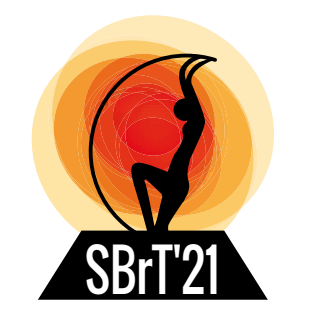
XXXIX Simpósio Brasileiro de Telecomunicações e Processamento de Sinais
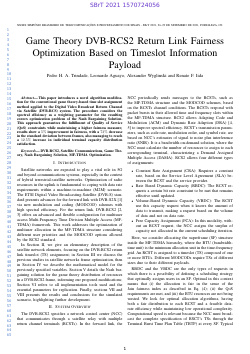
Game Theory DVB-RCS2 Return Link Fairness Optimization Based on Timeslot Information Payload
Pedro H. A. Trindade, Leonardo Aguayo, Alexander M. Wyglinski, Renato Iida
DOI: 10.14209/sbrt.2021.1570724056
Keywords: DVB-RCS2 Satellite Communications Game Theory MF-TDMA Optimization
Abstract
This paper introduces a novel algorithm modification for the conventional game theory-based time slot assignment method applied to the Digital Video Broadcast Return Channel via Satellite (DVB-RCS) system. The procedure considers the spectral efficiency as a weighting parameter for the resulting convex optimization problem of the Nash Bargaining Solution. This approach guarantees the fulfillment of Quality of Service (QoS) constraints while maintaining a higher fairness measure; results show a 5% improvement in fairness, with a 73% decrease in the standard deviation between frames, also managing to reach a 12.5% increase in individual terminal capacity distribution satisfaction.Download
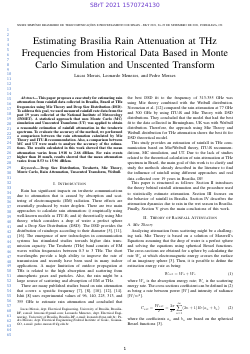
Estimating Brasilia Rain Attenuation at THz Frequencies from Historical Data Based in Monte Carlo Simulation and Unscented Transform
Lucas Vasconcelos de Morais, Leonardo Menezes, Pedro Moraes
DOI: 10.14209/sbrt.2021.1570724130
Keywords: Drop Size Distribution Terahertz Mie Theory Weibull
Abstract
This paper proposes a case study for estimating rain attenuation from rainfall data collected in Brasilia, Brazil at THz frequencies using Mie Theory and Drop Size Distribution (DSD). To address this goal, we used measured rainfall rate data from the past 19 years collected at the National Institute of Meteorology (INMET). A statistical approach that uses Monte Carlo (MC) simulation and Unscented Transform (UT) was applied to obtain a reasonable estimation of rainfall attenuation in the terahertz spectrum. To evaluate the accuracy of the method, we performed a comparison between the rain attenuation calculated by Mie Theory and ITU-R recommendation. Also, a comparison between MC and UT were made to analyze the accuracy of the estimations. The results calculated in this work showed that the mean attenuation varies from 1.918 to 2.66 dB/km. For rain events higher than 10 mm/h, results showed that the mean attenuation varies from 8.53 to 15.96 dB/km.Download
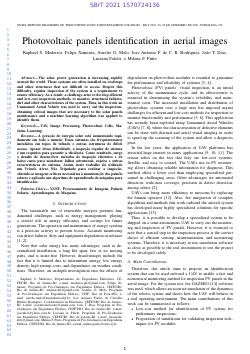
Photovoltaic panels identification in aerial images
Raphael Medeiros, Felipe Ximenes, Aurelio Melo, Jose Antonio Fontes de C. Ribeiro Rodrigues, João T Dias, Luciana Faletti, Milena Pinto
DOI: 10.14209/sbrt.2021.1570724136
Keywords: UAV Image Processing Photovoltaic Cells Machine Learning
Abstract
The solar power generation is increasing rapidly around the world. These systems are often installed on roofstops and other structures that are difficult to access. Despite this difficulty, regular inspection of the system is a requirement to ensure efficiency. As a result, a challenge arise to develop efficient and low-cost inspection methods to monitor structural failures, dirt and other characteristics of the system. Thus, in this work an Unmanned Aerial Vehicle was used to carry out the inspection, obtaining critical images that are necessary to the solar panels maintenance and a machine learning algorithm was applied to identify them.Download
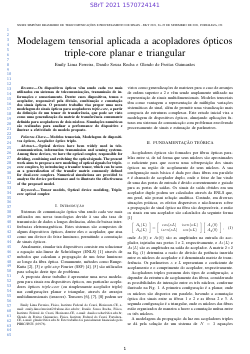
Modelagem tensorial aplicada à acopladores ópticos triple-core planar e triangular
Emily L Ferreira, Danilo Sousa Rocha, Glendo de Freitas Guimarães
DOI: 10.14209/sbrt.2021.1570724141
Keywords: Tensor models Optical device modeling Triple-core optical coupler
Abstract
Optical devices have been widely used in telecommunication, information transmission and sensing systems. Among these devices, we have the optical coupler, responsible for dividing the light beams and switching the optical signals. The present work aims to propose a new modeling of optical signals for triple-core couplers, by introducing a transfer tensor, which can be seen as a generalization of the transfer matrix commonly defined for dual-core couplers. Numerical simulations are provided to analyze the device performance and to illustrate the effectiveness of the proposed model.Download

Clusterização de Empresas da Bovespa
Rafael Augusto Pedriali, Plinio Santini Dester
DOI: 10.14209/sbrt.2021.1570724145
Keywords: clusterização machine learning Bovespa análise fundamentalista
Abstract
O objetivo desse trabalho é clusterizar as empresas de capital aberto da bolsa de valores brasileira utilizando uma abordagem fundamentalista, sem envolver o preço das ações na análise, apenas os fundamentos de cada empresa, e.g., indicadores que relacionam as métricas dívida, receita, lucro, fluxo de caixa, patrimônio líquido e ativos de cada companhia. Foi utilizada a abordagem aglomerativa de clusterização com os métodos single, average, complete e ward linkage, sendo selecionado o mais adequado em relação às métricas de desempenho de clusters: Silhouette coefficient, Davies-Bouldin e Calinski-Harabasz score e também em relação à aplicação final, isto é, auxiliar nas decisões de investimento.Download
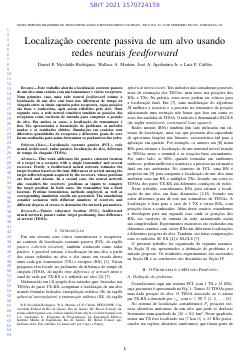
Localização coerente passiva de um alvo usando redes neurais feedforward
Daniel Nicolalde Rodríguez, Wallace A. Martins, José Antonio Apolinário Jr., Luiz Caloba
DOI: 10.14209/sbrt.2021.1570724159
Keywords: Localização coerente passiva passive coherent location rede neural feedforward radar passivo
Abstract
This work addresses the passive coherent location of a target in a scenario with a single transmitter and several receivers. Firstly, a feedforward neural network estimates the target location based on the time differences of arrival among the target-reflected signals acquired by the receivers, whose positions are fixed and known. In a second case, the neural network also considers the receivers' positions as inputs to compute the target position. In both cases, the transmitter has a fixed location. Problem formulation, methods employed, as well as corresponding simulation results are presented. The simulations consider scenarios with different numbers of receivers and different degrees of errors to determine the network parameters.Download
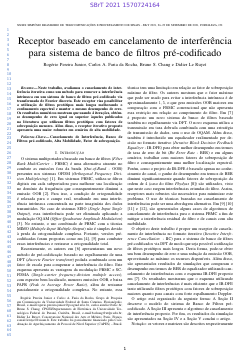
Receptor baseado em cancelamento de interferência para sistema de banco de filtros pré-codificado
Rogério P Junior, Carlos Aurélio Faria da Rocha, Bruno Chang, Didier Le Ruyet
DOI: 10.14209/sbrt.2021.1570724164
Keywords: Cancelamento de Interferência Banco de Filtros pré-codificado Alta Mobilidade Fator de sobreposição
Abstract
Neste trabalho, avaliamos o cancelamento de interferência iterativa como um método para remover a interferência intrínseca em um sistema de banco de filtros pré-codificado via DFT. Este receptor visa possibilitar a utilização de filtros protótipos mais longos melhorando o confinamento espectral e manter o mesmo desempenho de erro. Os resultados numéricos mostram que usando 4 iterações, obtém-se desempenho de erro igual ou superior àqueles publicados na literatura que utilizam filtros protótipos com fatores de sobreposição menores. Além disso, o receptor iterativo proposto apresenta uma maior robustez em cenários de alta mobilidade.Download

Analysis of the optimal time delay for Reconstruction of Phase Space of VCG signals to identify anterior wall infarction
Rafael Duarte de Sousa, José Barbosa, Ana Nogueira Rodrigues De Oliveira, Carlos Danilo Miranda Regis
DOI: 10.14209/sbrt.2021.1570724165
Keywords: Reconstructed Phase Space Anterior Myocardial Infarction Deep Neural Network Vectorcardiogram
Abstract
Acute Myocardial Infarction (MI) can be detected through Reconstructed Phase Space (RPS) parameters. The RPS is dependent on a time delay (τ) that can be a fixed or an optimal value based on the mutual information between a vectorcardiogram lead and its delayed version. This paper aims to assess the effect of an optimized time-delay in the detection of MI in the anterior wall using RPS parameters. For optimal τ values the sensitivity, specificity, accuracy and AUC obtained were: 64.7%, 63.2%, 57.8% and 62.3%, respectively; while for a fixed τ value were, respectively, 81.3%, 74.5%, 64.9% and 70.1%.Download

Blind Source Separation Methods for Video-based Structural Dynamics: A Comparative Study
Thaisse Paes, Moisés Felipe Silva, Joao Weyl Costa
DOI: 10.14209/sbrt.2021.1570724169
Keywords: Video-based Structural Dynamics Blind Source Separation Dimensionality Reduction Modal Analysis
Abstract
Operational modal analysis has been effectively used for video-based structural dynamics identification in recent years. With several different approaches, the ones based on the blind source separation strategy have received increased attention for identifying structural dynamics characteristics. This work presents a comparison study on the blind source separation techniques for videos of vibrating structures. Two dimensionality reduction techniques are used for video compression along with six source separation algorithms, resulting in twelve different frameworks tested over a laboratory cantilever beam structure. For specific algorithms, the results indicate that dimensionality reduction techniques play a major role in the mode estimation performance.Download
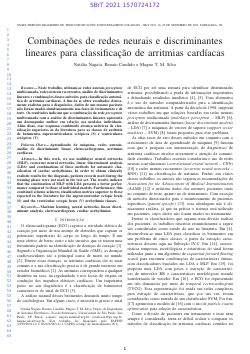
Combinações de redes neurais e discriminantes lineares para classificação de arritmias cardíacas
Natália Nagata, Renato Candido, Magno T. M. Silva
DOI: 10.14209/sbrt.2021.1570724172
Keywords: Machine learning Neural networks Linear discriminant analysis Electrocardiogram
Abstract
In this work, we use multilayer neural networks (MLP), recurrent neural networks, linear discriminant analysis (LDA) and combinations of these methods for automatic classification of cardiac arrhythmias. In order to obtain clinically realistic results for the diagnosis, patients records used during the training phase were not used in the test set. The results indicate that the combination of MLP with LDA presents a better performance compared to those of individual models. Furthermore, this combined scheme achieves classification metrics superior to those reported in the literature for the supraventricular ectopic beats (S) and the ventricular ectopic beats (V) arrhythmia classes.Download